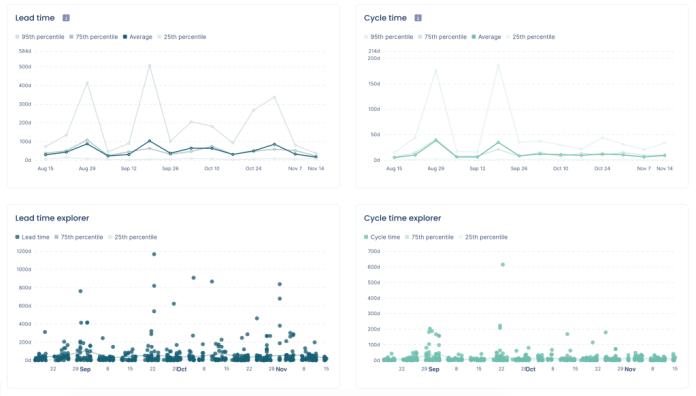Cycle Time vs. Velocity: understanding the key differences

Velocity and Cycle time are two standard metrics to measure the efficiency and effectiveness of software development teams. They help you estimate how long it will take for your team to complete a piece of work.
Although both metrics are important, Cycle time is typically more useful. In this article, we’ll understand why by examining the differences between Velocity and Cycle time. Let’s dive in!
Learn more about essential Dora metrics here
Velocity: the measure of team efficiency
Velocity is a metric that measures the amount of work your team can complete in a given period, usually measured in weeks. You can calculate it by summing up the number of story points your team finishes in a Sprint. Story points estimate the effort required to complete a user story or a feature, considering factors such as complexity, risk, and uncertainty.
Velocity is a helpful metric for estimating how much work your team can complete in future Sprints. It can also help your team identify potential bottlenecks and areas for improvement. However, Velocity should not be used as the sole measure of team productivity or performance, as it does not consider the quality of the work done or the time it takes to complete individual tasks.
Cycle time: the measure of process efficiency
Cycle time is a metric that measures the time it takes for a team to complete individual tasks from start to finish. You can calculate it by measuring the time it takes for a task to move from the “In Progress” to the “Done” column on a Kanban board or a similar workflow management tool.
Cycle time is a valuable metric for measuring the efficiency of the software development process since it considers the time it takes to complete individual tasks and the quality of the work done. It can also help your team identify bottlenecks and areas for improvement and implement changes that can lead to faster and more efficient development cycles.
Learn more about best practices for reducing cycle time here
Cycle time vs. Velocity: benefits explained
You can use Velocity and Cycle time in various ways, but they are not interchangeable. However, they are both typically used for planning estimates, so let’s analyze them with that goal in mind. But remember that choosing the right metrics also greatly depends on your context.
Cycle time is harder to manipulate
Several teams use story points to estimate time-bound work. However, the size of a story point is subjective, letting each team have its definition. This subjectivity makes Velocity easy to manipulate: to increase Velocity, you just need to overestimate how long it will take to complete a task and add a larger number to your issue tracker.
While Cycle time is a more objective measurement than story points, you can also manipulate it if you lower the scope of work you complete in a given cycle. However, this will likely work in your favor since most teams typically work on huge issues. In the end, splitting the work into smaller batches helps your team iterate faster.
Cycle time gives time back to your team
Measuring Velocity comes with the overhead of planning since your team needs to meet to estimate the effort of different tasks. This represents additional work and occupies time for your team.
Cycle time helps you spot outliers and get better at planning
Open discussions about outliers are an excellent way to improve your team’s ability to plan and estimate work. Understanding why a specific task took much longer than expected can help you identify bottlenecks and better plan as a team.
On the other hand, Velocity has an extra abstraction level with story points. That makes it harder for your team to discuss why a specific task took longer than planned. Without that conversation, improving your team’s planning precision over time is almost impossible.
Cycle time is linked to improved business results
Of Velocity and Cycle time, the latter is the only metric directly linked to business outcomes. And while this is not related to planning, it’s still worth analyzing.
The DORA (DevOps Research and Assessment) team has been researching the connection between Cycle time and business results. One of the conclusions is that this metric can determine how fast you can ship value to your customers, allowing you to improve your speed and surpass the competition.
Plus, teams that ship faster have more opportunities to learn and improve their planning accuracy.
Learn more How to determine your goals and metrics to adopt a data-informed culture
With tools like Codacy Pulse, measuring Cycle time doesn’t add extra meetings and allows your team to focus on what they do best.

Should you only focus on Cycle time?
Cycle time helps improve planning accuracy, but it’s not the only metric you should track. If you focus solely on Cycle time, you comprise other vital aspects of your team’s productivity.
How should you decide what to measure, then? The SPACE framework aims to offer a holistic approach to measuring developer productivity. It’s a research-based framework with five dimensions that comprehensively assess your team’s productivity.
The dimensions in the SPACE framework help engineering and tech leaders empower their teams to take ownership of their work, develop their skills, and accomplish goals while contributing to the team’s success. You can take a closer look at this framework when considering which metrics to adopt in your organization.
[Webinar] Leading your team to Engineering Excellence
Join our guest speaker Steve Berczuk, Lead Software Engineer at Riva Health, and Stuart James, Engineering Manager at Codacy, in discussing how to help your team achieve engineering excellence.
.svg)


